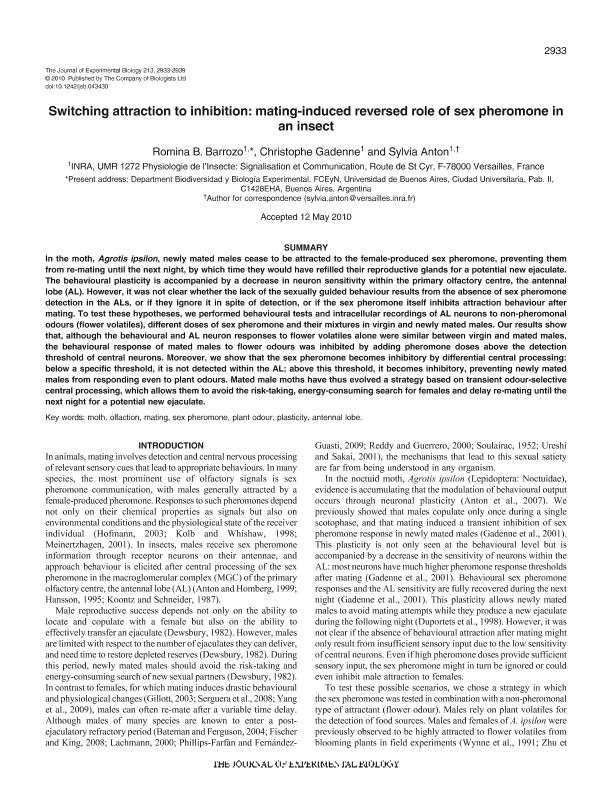Mostrar el registro sencillo del ítem
dc.contributor.author
Barrozo, Romina

dc.contributor.author
Gadenne, Christophe

dc.contributor.author
Anton, Sylvia

dc.date.available
2019-01-21T22:29:48Z
dc.date.issued
2010-09
dc.identifier.citation
Barrozo, Romina; Gadenne, Christophe; Anton, Sylvia; Switching attraction to inhibition: Mating-induced reversed role of sex pheromone in an insect; Company of Biologists; Journal of Experimental Biology; 213; 17; 9-2010; 2933-2939
dc.identifier.issn
0022-0949
dc.identifier.uri
http://hdl.handle.net/11336/68347
dc.description.abstract
In the moth, Agrotis ipsilon, newly mated males cease to be attracted to the female-produced sex pheromone, preventing them from re-mating until the next night, by which time they would have refilled their reproductive glands for a potential new ejaculate. The behavioural plasticity is accompanied by a decrease in neuron sensitivity within the primary olfactory centre, the antennal lobe (AL). However, it was not clear whether the lack of the sexually guided behaviour results from the absence of sex pheromone detection in the ALs, or if they ignore it in spite of detection, or if the sex pheromone itself inhibits attraction behaviour after mating. To test these hypotheses, we performed behavioural tests and intracellular recordings of AL neurons to non-pheromonal odours (flower volatiles), different doses of sex pheromone and their mixtures in virgin and newly mated males. Our results show that, although the behavioural and AL neuron responses to flower volatiles alone were similar between virgin and mated males, the behavioural response of mated males to flower odours was inhibited by adding pheromone doses above the detection threshold of central neurons. Moreover, we show that the sex pheromone becomes inhibitory by differential central processing: below a specific threshold, it is not detected within the AL; above this threshold, it becomes inhibitory, preventing newly mated males from responding even to plant odours. Mated male moths have thus evolved a strategy based on transient odour-selective central processing, which allows them to avoid the risk-taking, energy-consuming search for females and delay re-mating until the next night for a potential new ejaculate.
dc.format
application/pdf
dc.language.iso
eng
dc.publisher
Company of Biologists

dc.rights
info:eu-repo/semantics/openAccess
dc.rights.uri
https://creativecommons.org/licenses/by-nc-sa/2.5/ar/
dc.subject
Antennal Lobe
dc.subject
Mating
dc.subject
Moth
dc.subject
Olfaction
dc.subject
Plant Odour
dc.subject
Plasticity
dc.subject
Sex Pheromone
dc.subject.classification
Otras Ciencias Biológicas

dc.subject.classification
Ciencias Biológicas

dc.subject.classification
CIENCIAS NATURALES Y EXACTAS

dc.title
Switching attraction to inhibition: Mating-induced reversed role of sex pheromone in an insect
dc.type
info:eu-repo/semantics/article
dc.type
info:ar-repo/semantics/artículo
dc.type
info:eu-repo/semantics/publishedVersion
dc.date.updated
2019-01-14T18:34:49Z
dc.journal.volume
213
dc.journal.number
17
dc.journal.pagination
2933-2939
dc.journal.pais
Reino Unido

dc.journal.ciudad
Cambridge
dc.description.fil
Fil: Barrozo, Romina. Institut National de la Recherche Agronomique; Francia. Consejo Nacional de Investigaciones Científicas y Técnicas; Argentina
dc.description.fil
Fil: Gadenne, Christophe. Institut National de la Recherche Agronomique; Francia
dc.description.fil
Fil: Anton, Sylvia. Institut National de la Recherche Agronomique; Francia
dc.journal.title
Journal of Experimental Biology

dc.relation.alternativeid
info:eu-repo/semantics/altIdentifier/doi/http://dx.doi.org/10.1242/jeb.043430
dc.relation.alternativeid
info:eu-repo/semantics/altIdentifier/url/http://jeb.biologists.org/content/213/17/2933
Archivos asociados
